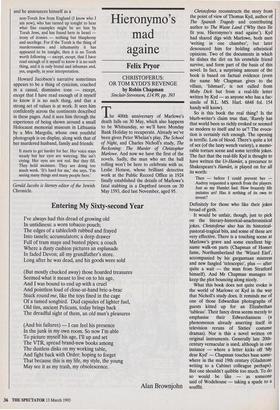Hieronymo's mad againe
Felix Pryor
CHRISTOFERUS: OR TOM KYDD'S REVENGE by Robin Chapman Sinclair-Stevenson, f14.99, pp. 393 The 400th anniversary of Marlowe's death falls on 30 May, which also happens to be Whitsunday, so we'll have Monday Bank Holiday to recuperate. Already we've been given Peter Whelan's play, The School of Night, and Charles Nicholl's study, The Reckoning:• The Murder of Christopher Marlowe. And now we have the first of the novels. Sadly, the man who set the ball rolling won't be here to celebrate with us. Leslie Hotson, whose brilliant detective work at the Public Record Office in 1924 finally established the details of Marlowe's fatal stabbing in a Deptford tavern on 30 May 1593, died last November, aged 95. Christoferits reconstructs the story from the point of view of Thomas Kyd, author of The Spanish Tragedy and contributing author to The Waste Land (Why then Ile fit you. Hieronymo's mad againe'). Kyd had shared digs with Marlowe, both men `writing in one chamber', but later denounced him for holding atheistical opinions. Two of the documents in which he dishes the dirt on his erstwhile friend survive, and form part of the basis of this novel. In fact, a surprising amount of the book is based on factual evidence (even the name Mr Chapman gives to the villain, 'Ishmael', is not culled from Moby Dick but from a real-life letter written by Kyd — as anyone who has a fac- simile of B.L. MS. Hari. 6848 fol. 154 handy will know).
So is this book the real thing? Is the blurb-writer's claim true that, 'Rarely has that world been so richly evoked or seemed so modern to itself and to us'? The evoca- tion is certainly rich enough. The opening is terrific. Lots of blood. There's quite a lot of sex (of the lusty wench variety), a memo- rable torture scene and some terrible jokes. The fact that the real-life Kyd is thought to have written the Ur-Hamlet, a precursor to Shakespeare's Hamlet, is played on for all its worth:
Then — before I could prevent her Audrey requested a speech from the players. Just as my Hamlet had. How brazenly life imitates art! Has it nothing of its own to invent?
Definitely for those who like their jokes broad of girth.
It would be unfair, though, just to pick on the literary-historical-anachronistical jokes. Christoferus also has its historical- pastoral-tragical bits, and some of these are very effective. There is a touching scene at Marlowe's grave and some excellent big- name walk-on parts (Chapman of Homer fame, Northumberland the 'Wizard Earl', accompanied by his gargantuan mistress and new fangled 'telescopic'', plus — after quite a wait — the man from Stratford himself). And Mr Chapman manages to keep the plot bouncing along nicely.
What this book does not quite evoke is the world of Marlowe or Kyd in the way that Nicholl's study does. It reminds me of one of those Edwardian photographs of guests kitted up for an Elizabethan `tableau'. Their fancy dress seems merely to emphasise their Edwardianness (a phenomenon already asserting itself in television reruns of Sixties' costume dramas). Nor is this a novel written on original instruments. Generally late 20th- century vernacular is used, although in one instance — where a letter kicks off 'My dear Kyd' — Chapman touches base some- where in the mid 19th century (Gladstone writing to a Cabinet colleague perhaps). But one shouldn't quibble too much. To do so would be like — as someone said of Wodehouse — taking a spade to a soufflé.


























































 Previous page
Previous page